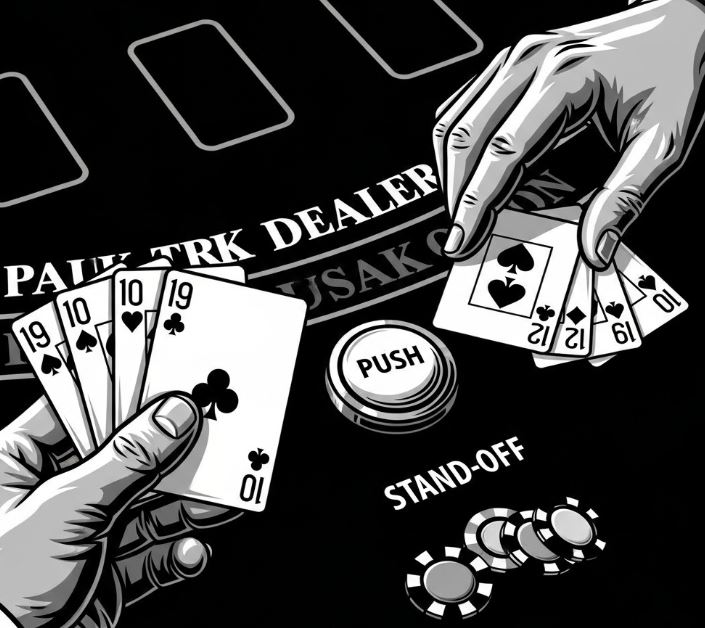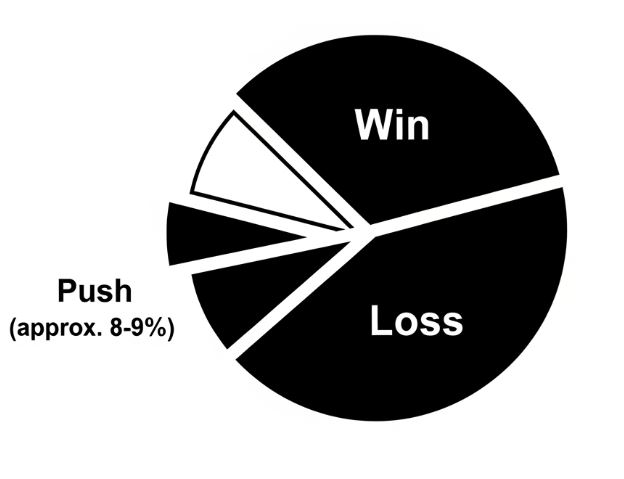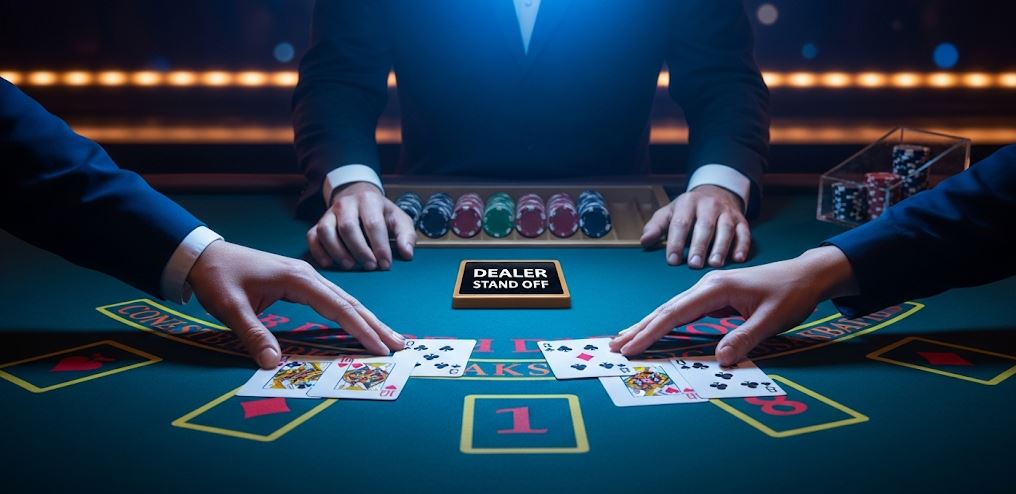Experience the thrill of Blackjack A tie? We debunk the myths and show you how you can master this situation to your advantage!

1. what exactly does "push" mean in blackjack?
An Blackjack tiealso known as a "push", is the moment when the Blackjack tablewhich often causes confusion or disillusionment. Imagine you have a sheet that is 20 Points and the dealer turns over his second card - also a 20. What happens now? Quite simply: it's a draw. Neither you nor the dealer win or lose it. Your original Insert remains and is returned to you. It is as if the game is paused for this round without changing your account balance.
This state is of fundamental importance for the game and its dynamics. Many players, especially beginners, often see a tie as a lost opportunity. But far from it! A push is by no means a negative result. It saves you from a loss and gives you the opportunity to try your luck again in the next round without losing capital. It is a neutral outcome that emphasizes the essence of blackjack as a game of probabilities and thrills. Understand: the tie is your friend if you want to avoid a loss. It's the buffer that keeps you in the game and gives you time to adjust your strategy or wait for better odds. Cards to wait.
Where do we play blackjack online?
My best online casino experiences I have in the Bizzo Casino made. In my opinion, there are the UNBEATABLE BEST SELECTION at tables with live dealers, where we train for the real casino. In contrast to many other online Casinos the winnings here are also paid out really quickly and reliably. That's why I can definitely recommend Bizzo Casino!
The Bizzo Casino offers numerous live blackjack tables and a fast Payout of our profits.

It is important to clearly distinguish a tie from a direct win or loss. A win means that your stake is doubled (or even paid out 2.5 times in the case of blackjack, depending on the rules). A loss, on the other hand, means that your stake is gone.
2. the psychological effect of a tie on the player

Have you ever wondered why a Blackjack tie often causes such a mixed reaction? On the one hand, it's not a loss, which brings a certain relief. On the other hand, it can feel like a missed opportunity, especially if you thought you had a strong hand. This ambivalence is deeply human and reflects the complex emotional facets of gambling. It is the difference between what is rational and what we desire.
For many players, especially those with a more aggressive style of play, a push can be frustrating. They are out to win and increase their bankroll. A tie means standing still, and standing still can be perceived as a step backwards. Understand: The blackjack table does not forget greed.
Our best blackjack online casinos

🔄 + 150 Free Spins



🔄 + 175 Free Spins



🔄 +150 Free Spins



🔄 + 150 Free Spins





On the other hand, a tie can be a welcome respite for cautious players or those on a losing streak. It is a confirmation that they have stopped losing and offers a chance to regroup. These players see the tie as a protective mechanism that preserves their capital. Understanding the psychology of the tie is the first step to mental strength in the game.
3. tie vs. win vs. loss: the subtle differences
The Blackjack tie is one of the three possible outcomes of a blackjack round, and it is crucial to fully grasp its specifics compared to a win or loss. Imagine you're sitting at the table, the cards are dealt, and now comes the moment of truth. What exactly differentiates these three scenarios from each other, and why is this understanding so important to your game strategy? Let's break it down.
An Profit is every player's dream: your hand is higher than the dealer's, without 21 to exceed. Your original stake will be returned to you and you will also receive the same amount as winnings. For example, if you bet 10 euros and win, you get 20 euros back. With a natural blackjack (a Ace and a ten card) the payout is usually even higher, often 3:2, which would mean a 25 euro payback on a 10 euro bet. Winnings are the lifeline of your bankroll and the reason why you play in the first place. They validate your decisions and give you the mental boost to keep going.
An Loss is the exact opposite: your hand is lower than the dealer's, or you exceed 21 points ("bust"). In this case, your original bet is lost. If you have bet 10 euros and lose, these 10 euros are gone. Losses are an inevitable part of gambling and can be frustrating, but they are also a lesson. They show you that not every decision works out and that risk management is crucial. The trick is not to be discouraged by losses and to remain disciplined. play.
The Tieour "push", occupies a special position. Your hand has the same value as the dealer's. Your stake is returned to you, there is no win or loss. If you bet 10 euros and there is a push, you get your 10 euros back. This may sound unspectacular, but this neutral outcome is a protective shield. It protects you from a loss and gives you another chance without you having to invest capital again. It interrupts a potential losing streak and keeps you in the game. The long-term significance of the tie is that it smooths out the variance in the game and allows you to stay at the table longer and wait for the winning hands. Internalize these differences and you will become a more aware and strategic blackjack player.
4. strategic considerations: When a tie becomes an advantage
The Blackjack tie may seem uneventful at first glance, but for the strategically-minded player it holds subtle advantages. When exactly can a push become your ally, and how do you integrate this understanding into your playing style to benefit from it in the long term? The answer lies in the fine balance between risk, reward and bankroll dynamics. Let's explore the strategic nuances.
A tie is always an advantage when it averts a potential loss. Imagine you have a marginal hand where you feel that a hit could get you over 21, but a stand is likely to make you lose. If the dealer also has a risky hand in this situation and ends up with a push, you have achieved the best possible result: Your capital is safe. This is particularly important in phases when your bankroll is under pressure. A tie stabilizes your situation and prevents you from slipping even deeper into the red. It is a silent savior that allows you to play more rounds at the table.
Blackjack is a game that is characterized by fluctuations. You will experience winning streaks and losing streaks. Ties help to dampen these swings.
In addition, a tie can indirectly influence the card count. Although it does not directly change your hand, it does influence the ratio of high to low cards in the deck, as the cards from this round are not removed from the game, but only "neutralized". This may be irrelevant for casual players, but is important for advanced players. Strategies of importance.
5. variations of the tie: dealer rules and their effects
The Blackjack tie is basically always a draw, but the specific Rulesthat apply to the dealer can subtly influence the frequency and perception of the tie. Have you ever wondered why in some casinos the dealer has to draw another card on a soft 17 (an ace and a 6), while in other casinos he has to stand still? These seemingly small differences have a significant impact on the probability of a tie and therefore also on your own strategy. Let's decipher these subtleties.
The most common variation concerns the dealer rule for a soft 17. In many casinos, the dealer must "hit" (draw another card) for a soft 17. This increases the probability that the dealer will bust, but can also lead to the dealer forming a stronger hand. For the player, this means that the probability of a tie decreases slightly, as the dealer is less likely to stay exactly on 17. On the other hand, it increases your Oddsif the dealer goes bust. This rule tends to be more advantageous for the player, as it slightly reduces the house advantage.
In contrast to this is the rule that the dealer must "stand" (remain standing) on a soft 17. This rule is less advantageous for the player, as the dealer holds a "safe" hand of 17 and busts less often. This increases the likelihood that you will need a higher hand than 17 to win and can therefore slightly increase the frequency of ties, especially if you have a 17 yourself. It is crucial to know this specific rule before you sit down at a blackjack table, as it can minimally affect your basic strategy.
In addition to the soft 17 rule, there are also rarer variations, such as rules that allow the dealer to draw or stand on certain values that go beyond the standard 17. However, these are less common. Understanding these dealer rules is not only important for theory, but also directly influences the probabilities in the game. A conscious player always informs himself about the specific rules of the table in order to adapt his strategy optimally. The nuances of the dealer rules are another piece of the puzzle in the complex blackjack cosmos and an indicator of how in-depth the game can be.
6. frequency of ties: Surprising statistics

How often does it actually come to a Blackjack tie? This question may sound simple, but the answer is more complex and intriguing than you might think. Statistics are the backbone of any card game, and blackjack is no exception. The frequency with which a push occurs is not just an interesting side note, but also has a direct impact on the variance of your game and your long-term chances of winning. Let's dive into the world of numbers and be surprised by the mathematics of the tie.
The exact probability of a tie depends on several factors, including the number of decks in play, the specific dealer rules (as described above, especially for Soft 17) and the exact composition of the remaining cards in the shoe. On average, and this is the surprising finding, a tie is far more common than many players suspect. Studies and simulations show that a push occurs in around 8 to 9 percent of rounds. This means that almost every tenth round ends in a draw.
This high frequency has a direct impact on the players' expectations. If you know that you have to expect a tie every ten rounds on average, you can adjust your mental attitude accordingly. It helps to avoid frustration when another push occurs and instead accept the neutral nature of this event. For professional For players or those who use strategies such as card counting, the frequency of ties is an important part of their calculations. It influences the effectiveness of certain strategies and the prediction of short-term volatility.
A look at the mathematics of blackjack shows that the House edge of the casino is created by these probabilities. The low probability of a tie compared to the probabilities of winning or losing, in combination with the Payout ratiosforms the long-term advantage of the house. Knowing the frequency of ties allows you to set realistic expectations for your game results and build your game on a sound, statistical basis. It's another indication that blackjack is far more than just luck - it's a game of numbers, probabilities and smart decisions.
7. the tie in the context of bankroll management
The Blackjack tie is far more than just a neutral score; it is a silent ally in the art of bankroll management. Imagine your bankroll is your financial backbone at the gaming table. Every win strengthens it, every loss drains it. Where does the Push fit into this picture? It is the stabilizer that protects your bankroll and gives you longevity in the game. Let's explore how this inconspicuous game outcome can play a crucial role in your financial strategy.
In the dynamic world of blackjack, where luck and bad luck often alternate, the tie is an important protective mechanism. It means that your stake is not lost and is available for the next round. This is invaluable, especially in phases where the cards are not falling optimally. While a losing streak can quickly shrink your bankroll, ties break this negative trend. They give you the opportunity to "breathe" without suffering further losses. This is crucial to maintain discipline and not fall into panic reactions, which often lead to even greater losses.
For effective bankroll management, it is essential to minimize variance. Ties help to smooth out this variance. Imagine playing over a longer period of time. Without ties, winning and losing phases would alternate more abruptly, which could lead to greater fluctuations in your bankroll. Ties act like small buffers that soften the swings and allow for a steadier game. This is particularly beneficial for players who play on a limited budget and want to maximize their time at the table.
In the long run, the frequency of ties means that you risk your capital less often than if every round was either a win or a loss. This is a fundamental aspect of the house edge. The casino advantage arises not only from direct losses, but also from the rounds in which the player does not lose, but does not win either. But from a player's point of view, the tie is a blessing: it preserves your capital and extends your playing time. If you take bankroll management seriously, you will appreciate the value of every tie. It is a silent watchdog that watches over your financial resources and helps you stay in the game longer.
8. myths and misunderstandings surrounding the tie
The Blackjack tie is surrounded by some persistent myths and misconceptions that often distort its true nature. Many players, even experienced ones, fall victim to these misconceptions, which can negatively impact their decisions at the table. It's time to debunk these myths and bring the facts to light so you can develop a clearer and more strategic understanding of this unique game outcome.
One of the biggest myths is that a tie is "bad luck" or a "lost opportunity". This is simply wrong. A tie is by definition a neutral result. Your stake remains unaffected, which means that you have neither won nor lost. The assumption that it is bad luck is often based on the desire to win every round. But in a game of probabilities, a draw is a protective mechanism that preserves your capital. By shedding this myth, you can reduce your frustration and develop a more objective perspective on the game.
Another misconception is that a tie somehow affects the probabilities for the next round. Some players believe that a push means that a win or a loss is more likely to occur in the next round. This is the gambler's fallacy in its purest form. Each round of blackjack is an independent event. The probabilities of drawing cards do not change based on the outcome of the previous round (unless you count cards and the composition of the deck has changed). A tie has no "redraw" effect on subsequent hands. Rely on math, not superstition.
Some also believe that certain actions such as "stand" or "hit" could increase or decrease the probability of a tie. While your decisions obviously affect the outcome of your hand, from the dealer's perspective and your final card value, the probability of a tie is fixed once all the cards are on the table. The best strategy to "influence" ties is simply to play the best basic strategy that maximizes your overall chances of winning and minimizes losses. It is important to recognize these myths and focus on facts in order to make informed decisions and understand the blackjack game in all its complexity.
9. from beginner to pro: how to use the tie to your advantage
The path from inexperienced beginner to accomplished blackjack pro is paved with the understanding of seemingly small details - and the Blackjack tie is one of those details that is often underestimated. As a player, how can you consciously use this neutral outcome to refine your strategy, strengthen your resilience and ultimately maximize your chances of winning? It's about developing a mental attitude that goes beyond just winning and losing.
For the beginner, the first step is to accept the tie for what it is: a neutral result. Instead of getting angry about a "missed" opportunity, you should realize that your capital is preserved. This is especially important when you're still learning and your bankroll may not be as large. Each push means you can play another round without risking your stake. Use these 'breathing spaces' to gather your thoughts, review your basic strategy and focus on the next hand instead of getting distracted by frustration.
For advanced players, the tie becomes an indicator of the game situation. For example, when counting cards, a tie affects the composition of the remaining deck differently than a win or loss. Although the cards from the current hand go back into the discard pile, the "effective" number of cards in the shoe is different. A push preserves the ratio of high to low cards better than if the dealer wins or loses a hand. This subtle understanding is crucial to the precision of your counting strategy and adjusting your bets.
At the professional level, it is about integrating the tie into the overall risk management. A professional knows that long-term profitability depends not only on winning hands, but also on minimizing losses. Ties help to reduce the loss rate and smooth out variance. They make it possible to bridge longer playing times and wait for the moments when the odds are on your side. Understanding the tie, its psychological Mastering impact and using it strategically is a hallmark of the true blackjack specialist. It's the ability to think outside the box and use every facet of the game to your advantage.
10 The evolution of equality: historical perspectives and modern interpretations
The Blackjack tie is as old as the game itself, but its perception and strategic importance have evolved over time. Let's take a journey through the history of blackjack and look at how this seemingly simple game outcome has been interpreted and understood from the early days of "vingt-et-un" to modern online casinos. This historical perspective helps us to fully grasp the deeper meaning of the tie in the context of the game.
In the early versions of vingt-et-un, the precursor to blackjack in the 17th and 18th centuries, the rules were often less standardized than they are today. The handling of a draw could vary from salon to salon. There were periods when a draw was considered a loss for the player, which significantly increased the house advantage and made the game much more ruthless. It was only with the consolidation of the rules, particularly in the American saloons of the 19th century, that the "push" became established as a neutral result as we know it today. This standardization was crucial to the popularity of the game, as it made it fairer and more predictable.
In the days of the card counting revolutions of the 20th century, led by greats like Edward O. Thorp and his seminal works, the tie was approached from a purely mathematical perspective. For mathematicians and statisticians, the push was an integral part of the probability calculations that define the house advantage. They understood that the tie helped to reduce variance and make the game more predictable over long periods of time, even if it didn't mean a direct payout. It was about integrating each outcome into the overall probability of winning formula.
In the modern era, especially with the advent of online blackjack and live dealer games, the interpretation of the tie has hardly changed, but its importance in the context of player psychology is more relevant than ever. In a world where instant rewards often take center stage, the tie is a reminder of the need for patience and discipline. It is a relic from a time when gambling was slower and more deliberate, and a reminder that not every round has to end with a big win. The evolution of the tie mirrors the evolution of the game itself: from its raw beginnings to a complex system of probabilities, psychology and strategy that captivates players worldwide. The tie is therefore not just a game outcome, but a testament to the history and timeless fascination of blackjack.
The comprehensive FAQ: Your questions, our answers
What is a "push" in blackjack?
A "push" in blackjack, also known as a tie, occurs when both the player and the dealer have the same total card value. In this case, the player's original bet is returned and there is no win or loss for that round. It is a neutral result that keeps the bankroll stable.
Does a tie count as a win or a loss?
No, a tie counts neither as a win nor as a loss. Your stake is simply returned to you. It's a draw that leaves your bankroll untouched for the next round and gives you another chance to try your luck.
Does a tie affect the probability of the next round?
No, a tie does not directly affect the probabilities of the next round. Each round of blackjack is an independent event. The cards that are drawn have no "memory effect" on the subsequent hands. Only when counting cards do ties have an indirect influence, as the cards are still removed from the game.
Is a tie good or bad for the player?
A tie is generally good for the player, as it averts a potential loss and protects the capital. It stabilizes your bankroll and allows you to stay at the table longer without taking additional risks. It is a neutral result that keeps you in the game.
How often does a tie occur in blackjack?
Statistically, a tie occurs relatively frequently in blackjack, usually in about 8 to 9 percent of rounds. The exact frequency depends on the specific rules of the table and the number of Decks of cards from.
What happens if I have blackjack and the dealer does too?
If both you as a player and the dealer have a natural blackjack (an ace and a 10 card), this is also a tie or push. Your original bet is returned to you and there is no payout as it is a tie.
Are there different types of ties?
The fundamental tie is always a draw in the Card value. However, there are different dealer rules (e.g. Dealer Hits Soft 17 vs. Dealer Stands Soft 17) that can influence the frequency with which a tie occurs. However, the mechanism of the push remains the same.
Can I use a tie strategically?
Yes, a tie can be used strategically by serving as protection for your bankroll. It helps to smooth out the variance and allows you to play more patiently. For card counters, it also influences the composition of the deck.
How does the tie affect the house advantage?
The tie is an integral part of the calculation of the house edge. It helps to reduce the casino's advantage as it prevents the player from losing in every tie situation, which would otherwise drastically increase the house advantage.
Should I change my strategy if there are a lot of ties?
No, your basic strategy should not change just because there are many ties. The basic strategy is mathematically optimized for all possible outcomes, including the tie. Focus on making the optimal decision for each hand, regardless of the previous pushes.
Glossary
- Bankroll: The total budget that a player has available for gambling.
- Basic Strategy (basic strategy): A mathematically optimized blackjack strategy that determines the statistically best decision based on your own cards and the dealer's visible card.
- Bust (overbuying): If the total value of a player's or dealer's cards exceeds 21. This automatically results in the loss of the round.
- Dealer (croupier): The person in the casino who deals the cards and runs the game.
- House Edge: The mathematical advantage that the casino has over the player in a game of chance.
- Hit: Request another card from the dealer.
- Push: A tie in blackjack where the player and dealer have the same card value and the bet is returned.
- Soft 17: A hand consisting of an ace and one or more cards that add up to 6 (e.g. Ace-6). The ace can be counted as 1 or 11.
- Stand (standstill): Do not request any more cards from the dealer and be satisfied with the current card value.
- Variance: The statistical fluctuation of results in a game of chance that deviates from the average expectation.
The crowning glory: your powerful summary
The Blackjack tie - a seemingly unspectacular draw that, on closer inspection, turns out to be a powerful tool in the hands of the informed player. We have learnedthat a push is far more than just a neutral result: it is a silent protector of your bankroll, a stabilizer in volatile phases of the game and an indicator of strategic thinking. Say goodbye to the myth that a tie is bad luck. Instead, it is a breathing space, a second chance and proof that you have not lost. By understanding the psychology of the tie, taking its statistical frequency into account and consciously incorporating it into your Bankroll Management you will elevate your blackjack game to a new level. It is the ability to recognize the greatest benefit in even the most inconspicuous moments that will take you from beginner to master. Use the tie as your ally and stay focused at all times - this way you will not only succeed at the blackjack table, but also in life.



